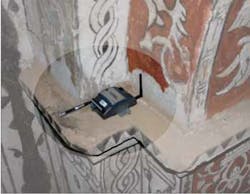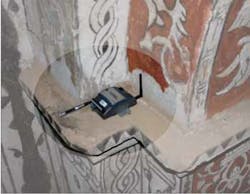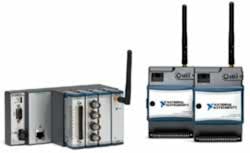As the world becomes increasingly interconnected, edge devices—often far removed from centralized computer systems—are delivering voluminous amounts of data. If such edge devices are in close proximity to centralized computer systems, they’re not running complex simulations but rather gathering modest amounts of data about temperature, humidity, airflow, and particle counts in server rooms.
Courtesy of National Instruments
Among the many other applications, such devices might be monitoring environmental conditions in structures or helping you find a parking place. For example, a conservation team in Spain used a remote sensor network to monitor temperature, humidity, and vibration with the goal of helping to preserve the Santa María de Mave Church and its monastery (Figure 1), which date back to the 12th century.1 And, Streetline Networks employs surface-mounted sensors to provide information that can help reduce the estimated 30% of urban traffic that results from drivers in search of parking spaces.2
Edge devices are key components of the Internet of things, but to be effective, they need a way to communicate with the Internet or a proprietary network. The communications link of choice often is wireless. In the case of the María de Mave Church, the communications link is made up of National Instruments’ wireless sensor network (WSN) products. In contrast, Streetline Networks employs radios and other components from Dust Networks in its smart parking systems.
WSN vs. Wireless DAQ
WSNs certainly are wireless data-acquisition systems, but there are key distinctions between WSNs and the traditional wireless DAQ systems described in EE’s February issue.3 Nicholas (Nick) Butler, product manager for wireless sensor networks at National Instruments, explained, “When we think DAQ, we think of tethered benchtop-type applications with I/O connected to a PC,” by a wireless tether in the case of wireless DAQ. According to Butler, other distinguishing characteristics of wireless DAQ applications are that they typically involve data collection over a specific period of time (often minutes or days), the PC generally is connected throughout the acquisition period, and data volumes can be high.
In contrast, Butler said, WSNs often serve in embedded applications and collect data for years and need not be connected constantly to a PC. Data rates might be modest, but it is critical that WSNs operate at very low power. Summarized Butler, “Wi-Fi DAQ [based on IEEE 802.11] has higher sample rates. You can stream waveform data. The WSN devices are based on 802.15.4 and ZigBee, which have significantly less throughput, but the trade-off is significantly longer battery life. Wi-Fi DAQ is very much about streaming waveform-type data at high data rates, and WSN is about collecting single samples or bursts of waveforms at longer intervals—maybe one sample per minute, one sample per hour, or one 1,000-point waveform every hour.”
National Instruments launched its first WSN products in 2009 and now offers several types of gateways and measurement nodes. “We have an analog-input voltage node,” Butler said. “We have one that can connect to thermocouples, one that can acquire resistance-based measurements, and one that can interface with RTDs. These different measurement nodes are placed in an environment to monitor either their ambient environment or maybe an asset.” Sensors, he said, connect via wires to the measurement nodes that, in turn, wirelessly connect to each other and to gateways to form a wireless mesh network.
Courtesy of National Instruments
NI also offers a variety of gateways. “One is a standalone embedded device that runs a real-time OS and can function headlessly, like some of our other embedded products,” said Butler. “Another gateway—the Ethernet gateway—can be tethered to a PC or another real-time embedded device.”
NI’s newest gateway (Figure 2) launched last November. Butler noted, “It plugs into the CompactRIO platform, which offers modular I/O in the form of our C Series I/O modules. We created a gateway in that C Series form factor so that you can plug it directly into a Compact RIO chassis and augment your existing high-speed wired measurement and control with Compact RIO along with wireless I/O in the form of a WSN. The CompactRIO could be sitting there controlling a machine and maybe acquiring some really high-speed waveform data, and then it also could remotely communicate with distributed WSN nodes.”
Butler explained that from a high-level view, nodes and gateways work together to collect, process, and store data and, depending on the type of gateway, determine whether a host is part of the system. He also noted that users can employ a LabVIEW add-on module to target and program the measurement nodes themselves.
“You can embed LabVIEW graphical programming onto the nodes and perform local data analysis or data reduction, and you can respond to network status changes. You can even perform event counting or local control using an on-off temperature function to turn on a fan, for example. All the logic happens on the node itself so you don’t have to incur network latency. Instead of sending measurements over the air and evaluating the data at the gateway or at the host, you can avoid sending the data and evaluate it right at the node,” he said.
Node-to-gateway distances reach a 300-m outdoor range for Americas’ versions of NI’s WSN products, Butler said, adding that specs differ slightly for international versions to deal with local compliance and certification issues. The 300-m range is the single-hop distance from any node to any other node or gateway, he explained, noting that you can implement a mesh network in which some of the nodes might function as routers.
“Think of a router as a repeater that allows you to extend the range or redundancy in your wireless network,” he said. “You might have a node that sends its data back through another node to yet another node or to the gateway. You could obtain distances of about 900 m away from a gateway by stringing nodes along and implementing router functionality and mesh-network topography.”
NI developers chose ZigBee and IEEE 802.15.4 as the basis for their WSN radios. Butler noted that these standards support low-power, self-healing, self-reorganizing mesh networking so, he said, “If any router or node goes down, the network will remesh and reconfigure so you don’t lose data. It eliminates downtime in the network.”
Butler explained NI’s choice of protocol: “There are several standards out there, and there was a bit of a standards battle going on when we were about to release our first WSN products. We already had 802.11 support with our wireless Compact DAQ. Alternatives included Bluetooth, ZigBee, WirelessHART, and ISA100. ISA100 had not been ratified when we were ready to launch, and we didn’t want to use something that wasn’t commercially available or proven in the industry. Bluetooth didn’t give the distances we needed. Cellular standards offer great distances but require high power consumption. When we looked at the cross section of slower data rates, longer distances, and lower power consumption, ZigBee was a really good choice,” although he acknowledged that ISA100 and WirelessHART are appearing in heavy industrial and oil and gas monitoring applications where features such as the redundancy associated with WirelessHART provide competitive advantages.
Although NI bases its WSN products on ZigBee and 802.15.4 (the former builds upon the PHY and MAC layers defined in the latter), Butler clarified that the company implements a proprietary network layer on top. He said, “We leverage the lower layers in the network stack, but we do implement some proprietary multiple handshakes and acknowledgement algorithms on top. So our network is, in fact, proprietary-enclosed even though based on Zigbee. We did that to ensure data reliability, the integrity of customers’ data, and the integrity of the network. We didn’t want random rogue ZigBee devices joining our gateway and choking out critical I/O nodes that were supposed to be part of that network.”
With NI’s approach, users need not contend with such issues. They just choose sensors, nodes, and gateways and can be confident that details relating to radio protocols and the establishment of mesh networking are already taken care of.
Choosing Your Own Components
If you want more flexibility in your WSN designs than the NI approach offers, you can buy your own radio, signal-conditioning, power-management, and power-harvesting components and integrate them into your design. Linear Technology—with its recent acquisition of Dust Networks—aims to become a one-stop shop for such components. The Dust acquisition added radios to Linear’s established line of signal-conditioning and power-management devices.
Erik Soule, vice president of signal conditioning products for Linear Technology, said, “There’s no doubt that more and more sensors are going wireless. Look at large process-control companies and people taking measurements in data centers.” When you consider installation and maintenance issues, he explained, “Wireless is such a natural way to go.”
From Linear’s perspective, wireless provides a new way of interfacing and forming the data path that begins with sensors. Soule said that although Linear does manufacture some RF devices, they target infrastructure applications, and Linear had offered no low-power transceivers before the acquisition.
Soule elaborated on Linear’s reasons for acquiring Dust: “Generally, [WSNs are] very low-power systems, so consider what technologies you must have to make [a WSN] come together. First, you need low-power signal-conditioning and data-acquisition hardware, and second, you must have some type of power management, whether you are using a primary cell, a secondary cell, energy harvesting, some other type of scavenged power source, or some combination. And third, you’ve got to have the network to link all these things together and get the data back to a computer.”
Linear, Soule said, has made a big push into energy harvesting, working with a variety of transducers to apply energy-harvesting techniques to charge a supercapacitor or battery. His own group, he indicated, has put a lot of effort into low-power signal conditioning, including amplification, filtering, and buffering to establish interfaces with a variety of sensors.
The Dust purchase, Soule said, added the third requirement—the radio and related software, with the latter being a big part of the complete system. He said the Dust products complement the Linear ones, noting that many Dust customers already are Linear customers.
Soule noted that Dust’s underlying radio can run a variety of software protocols. “WirelessHART is probably the most popular,” he said, “mainly because its predecessor, HART, which is just information modulated over a 4- to 20-mA signal, has been around for more than 30 years. WirelessHART is just a wireless implementation of that, if you will.”
A Dust product that runs WirelessHART is the SmartMesh™ IA-510 mote-on-chip system, which combines Dust’s intelligent networking platform and low-power radio technology in a 12-mm x 12-mm system-in-package (SiP). The company also offers the technology in the form of a 22-pin module (Figure 3).
Courtesy of Linear Technology
Dust also supports other standards that are gaining some momentum, Soule said, including ZigBee Green Power and 6LoWPAN. The latter is the Internet Engineering Task Force’s IPv6 over low-power wireless personal-area network standard, which extends Internet Protocol version 6 addressing capabilities to low-power edge devices inhabiting the Internet of things.
With the Dust acquisition, Linear gained access to Dust’s software as well as radios, and Dust, said Soule, has “many, many man-years invested in the software, and the software is not trivial.” Dust, he noted, has done a nice job in enabling the engineer writing the application code to focus just on reading from a sensor or writing something back out to a device at the fringe of the network.
“All that underlying networking software is really transparent,” Soule said, adding that some vendors “tend to provide you with a software stack and say go knock yourself out. These mesh networks are really not trivial to program because they are self-forming and self-healing, have channel hopping, and are all time-synchronized.”
As edge devices increasingly connect to the Internet of things, you can expect companies like NI and Linear Technology to expand their WSN-related offerings with nodes, gateways, modules, components, and software to help you get a WSN up and running. As for the underlying technology, said Soule, “It’s a general-purpose technology that’s going to be used all over the place.”
Companies will be offering services and reference designs as well as products. Butler at NI said his company offers an extensive selection of services, ranging from device calibration to in-field service and support via alliance partners. You can even contract an integrator to build a turnkey system. As for Linear Technology, Soule said the next step in the Linear/Dust partnership is the development of a reference design—“a tour de force of engineering that places all this technology in the hands of people and gets the creative juices flowing.”
References
1. González, J.J.C., et al., “Monitoring a 12th Century Historic Church With NI Wireless Sensor Networks and LabVIEW,” National Instruments Case Study.
2. “Reducing Traffic and Pollution, Making Happier Citizens and More Cost-Efficient Cities,” Dust Networks Case Study.
3. Nelson, R., “Wi-Fi Extends the Reach of Data Acquisition,” EE-Evaluation Engineering, February 2012, p. 12.
For More Information
• HART Communication Foundation
• International Society for Automation (ISA)



